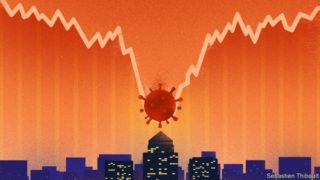A new type of creative destruction
RECESSIONS ARE capitalism’s sorting mechanism. Weak businesses shrink or fail and stronger ones expand. But in 2020 the process of creative destruction did not take place in the typical manner. Because the downturn was the result of a health crisis rather than, say, a financial crash or inflation scare, there were some idiosyncratic corporate winners and losers: think of the boom in video streaming, or cruise-liner firms being wrecked. Meanwhile vast state handouts propped up companies around the world, masking the scale of the corporate carnage. In 2021 the toll will become clearer as stimulus tapers down and more firms fail. Healthy businesses will ramp up investment, giving them an enduring advantage. These top dogs will, however, face a new climate in which three tenets of modern business—the primacy of shareholders, globalisation and limited government—are in flux.
Downturns tend to be infrequent and swift: since the second world war America has been in recession only 14% of the time. But they have a profound impact on the structure of business. During the previous three slumps the share prices of American firms in the top quartile of each of ten sectors rose by 6% on average, while those in the bottom quartile fell by 44%.
This time there have been some obvious winners. Silicon Valley’s prospects have soared as users have switched to digital services (see article). China Inc has had another great leap forward. Its domestic economy has outperformed most other countries’ and a wave of initial public offerings, including the fizzy flotation of Nongfu Spring, a bottled water colossus, has highlighted the strength and depth of Chinese firms. Their share of world stockmarket value (including Hong Kong) is now 17%, up from 15% before the pandemic and 13% a decade ago.
Winners and losers
Some success stories have been more unexpected. The Poonawalla family in India, who until recently were as well known for their stud farms as for their vaccine business, have seen their fortune rise by 62% to $14bn, according to Bloomberg. The container-shipping industry has spent years merging into a more efficient structure: the effort has paid off, with Maersk, the largest firm, predicting solid profits in 2020 despite a slump in trade. SoftBank, a Japanese conglomerate known for its wild tech bets and huge debts, has turned a crisis into an opportunity by announcing $80bn of asset sales. Gold-mining companies, long viewed as dead money, are back in fashion because some investors think huge government stimulus will lead to a bout of inflation in which bullion is one of the few assets to hold its worth.
What about the losers? Judged by the bottom line, business is in worse shape than in the subprime crisis: in the first half of 2020 more than 40% of America’s top 3,000 listed firms made losses, compared with just over a third in 2009. But default rates in America remained low, with only about 5% of junk bonds in default and about 4% of business credit cards in arrears.
In 2021 this unreal world won’t last. Governments will reduce new aid and pivot away from keeping individual firms alive and towards making sure workers have help if they lose their jobs. The gap between companies will also widen because stronger ones will maintain investment as others cut back. By mid-2020, capital spending at the ten highest-spending listed American firms was still 3% higher than a year earlier, but had dropped by 82% at the smallest 1,000 firms.
By Patrick Foulis: The Economist





